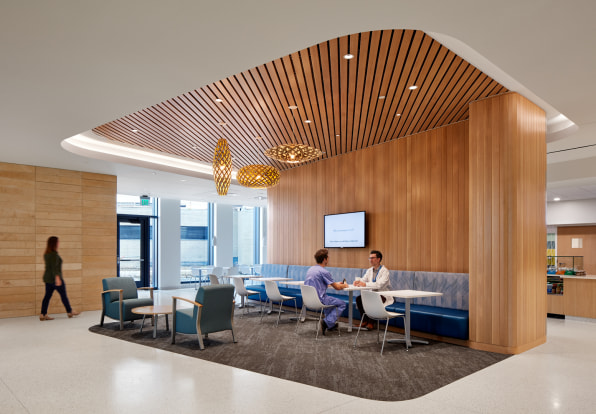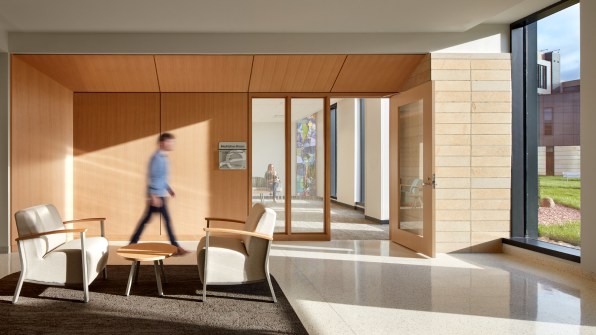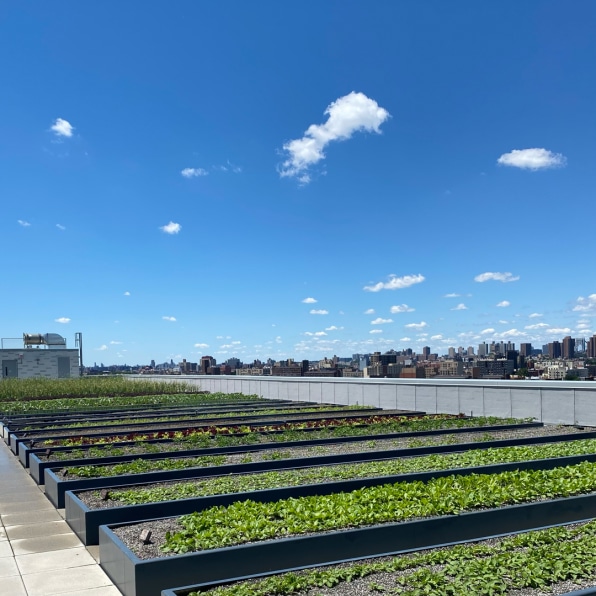
Among a certain subset of designers, there’s a growing feeling that the more natural a space is, the better. So-called biophilic design, or design that integrates nature and natural processes, is making its way into the world of architecture and urban development. In architecture, biophilia is seen as a way to make people happier and healthier by building nature into their daily lives, even when they’re in a city.
It’s a concept that’s particularly relevant in healthcare spaces like hospitals and clinics. Wellness and patient healing have been repeatedly shown to have close connections with the way spaces are designed, the amount of natural daylight they’re exposed to, even the views hospital rooms offer patients.
More and more, healthcare facilities are being designed with biophilic concepts from the start.
“We know that when people have better access to green space, natural areas, areas for rest and respite, places that might be away from cars, traffic, and noise, especially in urban centers, mental and physical health improve,” says Anjulie Palta, an urban designer at the architecture firm Cooper Robertson who’s focused on healthcare campus design. “There’s a huge opportunity for a hospital and its land holdings to capitalize on fulfilling its mission, and really its imperative, to address public health outcomes.”
 [Photo: Corey Gaffer/© Gaffer Photography/courtesy HGA]
[Photo: Corey Gaffer/© Gaffer Photography/courtesy HGA]
One example is the new St. Elizabeth Healthcare Cancer Center in Edgewood, Ky., just across the border from Cincinnati. When the hospital set out to design the facility, with the help of architecture firm HGA, its clinicians were ready with their own ideas. “I read for months before we even went to the original developmental design meetings,” says Dr. Douglas Flora, the center’s executive medical director of oncology services.
As a cancer patient himself, he understood that design could play a huge role in how patients experienced the often uncomfortable treatments. He started asking patients what they wanted in a new facility. “What I heard repeatedly is, ‘We don’t want sterile fluorescent lights. We don’t want to feel like we’re on a stage while we’re sitting on these high exam tables and freezing cold in gowns,’” he says. Patients wanted a softer experience, with more natural light, not the typical sterile white walls of a chilly hospital room.
 [Photo: Corey Gaffer/© Gaffer Photography/courtesy HGA]
[Photo: Corey Gaffer/© Gaffer Photography/courtesy HGA]
“As we met with the architects, we went with a full natural material palette for everything, lots of varying textures and colors all relating to nature, what we felt was more soft and inviting,” Flora says. He wanted the project to “echo more the feeling you get when you walk into an Apple Store than the feeling you get when you walk into your gynecologist’s office.”
The design went fully in on this softer approach, from the natural materials like wood used in patient and staff areas to the large walls of windows that line nearly every exam room, chemotherapy infusion space, and nurse station. The architects even used specific natural color tones to help differentiate departments and aid wayfinding—colors that at first felt a bit much. “They’re brighter and more cheery than I would have normally expected for a building,” says Flora, who describes himself as having “more of a Restoration Hardware, Pottery Barn kind of vibe.” The color scheme includes a lot of bright pastels and canary yellows. “The patients notice that those are uplifting spaces,” Flora says.
 [Photo: Corey Gaffer/© Gaffer Photography/courtesy HGA]
[Photo: Corey Gaffer/© Gaffer Photography/courtesy HGA]
The power of natural light was fully embraced in the lobby, which is covered by a ceiling-spanning skylight that sends diffused light below. “There’s a sense of healing when you walk in,” Flora says. The space also connects with the cancer center’s free patient amenities, including a demonstration kitchen, a yoga studio for staff and patients to use, an art-therapy studio, a music-therapy studio, massage and acupuncture spaces, and an aromatherapy area. Outside the center is a healing garden, which patients use to get fresh air. They’re all ways to reconnect patients with the natural flows of their bodies, and provide what Flora calls “whole person care.”
“When we built this we recognized that most of our patients were not interested primarily in just their CAT scans or their chemo regimens,” he says. “We really found that it enhances their life, and it treats the other stuff that maybe the doctors don’t get to in every single visit.”
Biophilic elements are seen as ways to expand what it means to provide health care. In New York City, another project has taken the biophilia concept and geared it around the health of the community. St. Barnabas Hospital, a Bronx-based institution dating back to the mid-1800s, has begun developing spaces that integrate health-focused design ideas. In its new Health and Wellness Center, a two-building affordable housing complex with healthcare services co-located inside, the hospital has integrated a connection to nature through food. The roof of one of the buildings houses an urban farm operated by the New York non profit Project EATS, which runs city-based farms in neighborhoods with poor access to fresh produce.
 [Image: Project EATS]
[Image: Project EATS]
The rooftop farm is directly linked with the healthcare services the hospital provides to residents and others on site. Part of the connection is made by getting residents involved in the farming process and eating the food produced. In partnership with Project EATS, the hospital’s doctors can prescribe patients healthy food grown on site and prepared in a 4,000-square-foot commercial kitchen on the building’s second floor.
According to Spencer Orkus, managing director at L+M Development Partners, which worked with St. Barnabas on the project, the buildings were developed “with the goal of not just providing space for health care and housing, but trying to address the social and environmental needs of people, particularly patients in the community.”
Linda Goode Bryant, founder of Project EATS, says access to healthy food is a major public health challenge in poor neighborhoods, and it’s even more important to bring food closer to residents who are dealing with their own health challenges. “The systems we have now make the food too distant from us,” Bryant says. Having a farm above the heads of St. Barnabas patients, she says, is an expansion of the work of the hospital’s doctors. “We’ve come to realize that there are so many benefits to a partnership like this,” she says. “As we interweave our programming we can have more impact in the community.”
Building the space was not without complications or costs. Orkus says the rooftop farm required specific structural planning in order to support the weight of the planters, a sealant to ensure it remained watertight, and, most expensive of all, a dedicated elevator. “As you can imagine, hauling soil and plants up and down, having the farm borrow the residential elevator would not be suitable for either party,” he says.
But making the investment is worthwhile, if just in terms of having the project further the mission of the hospital in a neighborhood that’s often underserved. “We’re a double bottom line company,” Orkus says. “We can do well while doing good.”
At the St. Elizabeth Cancer Center, Flora says the investments made in biophilic design—from the natural light and materials to the healing garden to the yoga studios and aromatherapy—are already paying off. “After the center opened, our volume soared,” he says.
Though he chooses not to frame it as a way to compete with other hospitals or healthcare centers, Flora says these design elements are definitely ways to show patients that cancer care can be more than just what happens in the exam room. “The building evokes that,” he says. “It really feels like a breathing organism.”


